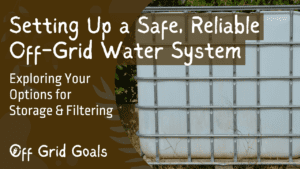Considering taking the plunge into off-grid homesteading?
Welcome to the wild and wonderful world of self-sufficiency!
Before you trade in your city life for the tranquility of the countryside, there are a few important things to consider and decide.
From the practicalities of water and power to the emotional and lifestyle changes, here are the five biggest things to think about when contemplating the off-grid homesteading lifestyle:
Location, Location, Location: The first and most crucial decision you’ll need to make is where to establish your off-grid homestead. Consider factors such as climate, soil quality, access to water, and local zoning regulations.
Are you drawn to the rugged beauty of the mountains, the rolling hills of the countryside, or the vast expanse of the desert? Do you crave the solitude of a remote location or the sense of community in a rural town?
And, what type of “roof over your head” do you want at your location? Consider what you’re going to live in and what’s allowed/required for the area you’re considering. Some areas allow RVs or camping for extended periods while others don’t. You may have permits and requirements for any building (minimum size, utilities, etc). Do your research so you don’t run into any huge surprises that derails your big plans.
Take your time to explore different areas and find the perfect spot that aligns with your vision for your homestead.
Water Source and Management: Water is the lifeblood of any homestead, so it’s essential to have a reliable and sustainable source of water.
Consider options such as wells, springs, rainwater harvesting, and surface water sources like rivers or ponds. Determine how you’ll collect, store, and distribute water for drinking, irrigation, and livestock.
Invest in water-saving technologies and conservation practices to minimize waste and ensure a steady supply of clean, potable water for your homestead.
Energy Independence: Off-grid living means saying goodbye to the convenience of grid-connected electricity and hello to self-generated power.
Consider options such as solar panels, wind turbines, hydroelectric systems, and biomass generators to meet your energy needs. Determine your power requirements and design a system that’s tailored to your homestead’s size, location, and climate.
Invest in energy-efficient appliances, LED lighting, and battery storage to maximize efficiency and minimize reliance on fossil fuels.
Food Production and Self-Sufficiency: Off-grid homesteading is all about growing your own food, raising animals, and embracing a self-sufficient lifestyle.
Consider options such as vegetable gardens, fruit orchards, livestock pens, and beekeeping hives to provide a diverse and abundant food supply for your family.
Learn about permaculture principles, regenerative agriculture practices, and heirloom varieties to maximize yields and promote sustainability.
As you continue building your homestead towards harvesting fresh produce, gathering eggs from the henhouse, and more, you’ll be able to go straight from the garden to the table.
Emotional and Lifestyle Considerations: Finally, it’s important to think about the emotional and lifestyle changes that come with off-grid homesteading.
Consider factors such as isolation, self-reliance, and the demands of rural living. Are you prepared to embrace the solitude of the countryside, the challenges of living off the land, and the rewards of a simpler, more sustainable lifestyle?
Take time to reflect on your values, priorities, and goals for the future, and make sure off-grid homesteading aligns with your vision for a fulfilling and meaningful life.
Off-grid homesteading is a lifestyle choice that requires careful consideration and planning if you want to succeed (without going crazy!). Take the time to dream big, plan wisely, and embrace the adventure of off-grid living—it’s a journey full of surprises, challenges, and rewards!



















